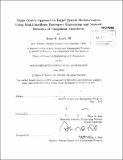| dc.contributor.advisor | Adam M. Ross. | en_US |
| dc.contributor.author | Roark, Henry H., III | en_US |
| dc.contributor.other | System Design and Management Program. | en_US |
| dc.date.accessioned | 2013-01-23T20:23:30Z | |
| dc.date.available | 2013-01-23T20:23:30Z | |
| dc.date.copyright | 2012 | en_US |
| dc.date.issued | 2012 | en_US |
| dc.identifier.uri | http://hdl.handle.net/1721.1/76570 | |
| dc.description | Thesis (S.M. in Engineering and Management)--Massachusetts Institute of Technology, Engineering Systems Division, System Design and Management Program, 2012. | en_US |
| dc.description | Cataloged from PDF version of thesis. | en_US |
| dc.description | Includes bibliographical references (p. 101-105). | en_US |
| dc.description.abstract | Deciding where to modularize a system can have long-term impact on that systems value over its entire lifecycle. The modularity of a system can impact the systems flexibility, evolvability, scalability, mass, costs, and development schedule. Making these modularization decisions is a key job of the system architect. There exists a need to provide the system architect tools that will help focus modularization efforts on the areas of the system that are most likely to provide value to stakeholders of the system. Using a terrestrial vehicle as a case study, an approach is developed that links component modularity to system design variables which are likely to change levels. The approach utilitizes Multi-Attribute Tradespace Exploration, Multi-Epoch Analysis, and network measures of component modularity to identify components which are most likely to need to change as well as the components ability to make a modularity change. It is found that the tools utilized can be successfully linked to provide early development phase information about value-centric system modularizations; the approach does require a network representation of the system earlier in the design cycle than it may be typically available. Using explicit knowledge, the approach developed can focus designers modularization efforts on the elements of the system that may need to change to accommodate changes in decision makers preferences, use contexts, or epoch contexts. The approach developed can aid the system architect modularizing a system so as to create a high amount of leverage for a systems stakeholders. | en_US |
| dc.description.statementofresponsibility | by Henry H. Roark, III. | en_US |
| dc.format.extent | 105 p. | en_US |
| dc.language.iso | eng | en_US |
| dc.publisher | Massachusetts Institute of Technology | en_US |
| dc.rights | M.I.T. theses are protected by
copyright. They may be viewed from this source for any purpose, but
reproduction or distribution in any format is prohibited without written
permission. See provided URL for inquiries about permission. | en_US |
| dc.rights.uri | http://dspace.mit.edu/handle/1721.1/7582 | en_US |
| dc.subject | Engineering Systems Division. | en_US |
| dc.subject | System Design and Management Program. | en_US |
| dc.title | Value centric approach to target system modularization using multi-attribute tradespace exploration and network measures of component modularity | en_US |
| dc.type | Thesis | en_US |
| dc.description.degree | S.M.in Engineering and Management | en_US |
| dc.contributor.department | System Design and Management Program. | en_US |
| dc.contributor.department | Massachusetts Institute of Technology. Engineering Systems Division | |
| dc.identifier.oclc | 823603237 | en_US |
